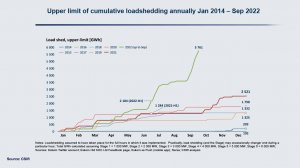Statistics released by the Council for Scientific and Industrial Research (CSIR) underlined how significantly loadshedding has intensified during 2022, which is the first year that the majority of the rotational cuts have been implemented at Stage 4, representing 4 000 MW of simultaneous cuts.
It is also the first year since 2019 that Stage 6 loadshedding was implemented, and for far longer periods (nearly ten times longer) than was the case three years ago.
The publication, released amid ongoing loadshedding by Eskom, shows that more rotational cuts were implemented in the three months from July to September than in any previous full year since the introduction of loadshedding by Eskom in 2007. It also confirms that there was more loadshedding in September alone than during 2020 as a whole.
Produced by Warrick Pierce and Monique Le Roux, the publication shows that 5 761 GWh of energy had been shed by the end of September, and 1 949 hours disrupted.
Loadshedding contributing the lion’s share of the 4 315 GWh of demand-side response implemented during the nine-month period, with the balance arising from interruptible contracts.
In 2021, previously South Africa’s worst-ever year for loadshedding, 2 521 GWh of energy was shed and 1 169 hours disrupted.
The intensification of loadshedding during the year led to the July 25 announcement by President Cyril Ramaphosa of a series of interventions to address ongoing power cuts, including the establishment of a National Energy Crisis Committee (Necom).
Three priority levers were identified to close the prevailing supply/demand gap, namely: improving the performance of Eskom’s coal fleet; procuring additional capacity from the non-Eskom sources of supply and scaling up demand-side management.
To support the stabilisation for the system Necom is also targeting the procurement of a further 2 295 MW during the coming 12 months, which could arise from ongoing and emergency procurement programmes, as well as imports from the region.
Some 1 450 MW of demand reduction is being targeted through various interventions, including power alerts and other measures to change consumer behaviour.
Recent market reform allowing embedded generation plant, initially below 100 MW in size, but eventually of any size, is expected to unlock further private supply, as is an Eskom initiative to lease grid-ready land parcels to independent power producers and generation investments by municipalities.
Eskom, meanwhile, expects to add 2 200 MW over the coming year from interventions primarily at six coal stations, namely Tutuka, Kendal, Duvha, Majuba, Matla and Kusile.
The maintenance effort will seek to decrease unplanned outages, which have contributed to the fall in the fleet energy availability factor (EAF), while commissioning the remaining new-build units, while addressing defects.
The CSIR statistics confirmed that the EAF of the entire Eskom fleet continued to decline in 2022, with the average weekly EAF for the year to date having fallen to 59.1% from 61.7% in 2021 and 65% in 2020.
The CSIR attributes the decline in the EAF largely to the increase in unplanned outages experienced by Eskom and also suggests that there has been a “flattening out” of the EAF during the year.
The capacity factors of the coal and nuclear plants both fell to 52.4% during the first half of 2022, having been 55.7% and 53% respectively in the corresponding period of 2021.
The statistics analyse by the CSIR cover all utility-scale generation technologies, including coal, nuclear, hydro, solar photovoltaics (PV), onshore wind, concentrated solar power (CSP), pumped storage and diesel-fuelled open cycle gas turbines.
They show that during the first half of 2022, the total system demand was similar to the year before, but still 3 TWh (2.5%) below the pre-Covid lockdown levels of 2019.
Coal continued to dominate the South African energy mix, meeting more than 80%, or 113 TWh, of the total system load.
The contribution of wind, solar PV and CSP increased in 2022 to a total of 6.2 GW installed capacity and provided 6.5% of the total energy mix.
EMAIL THIS ARTICLE SAVE THIS ARTICLE ARTICLE ENQUIRY
To subscribe email subscriptions@creamermedia.co.za or click here
To advertise email advertising@creamermedia.co.za or click here











